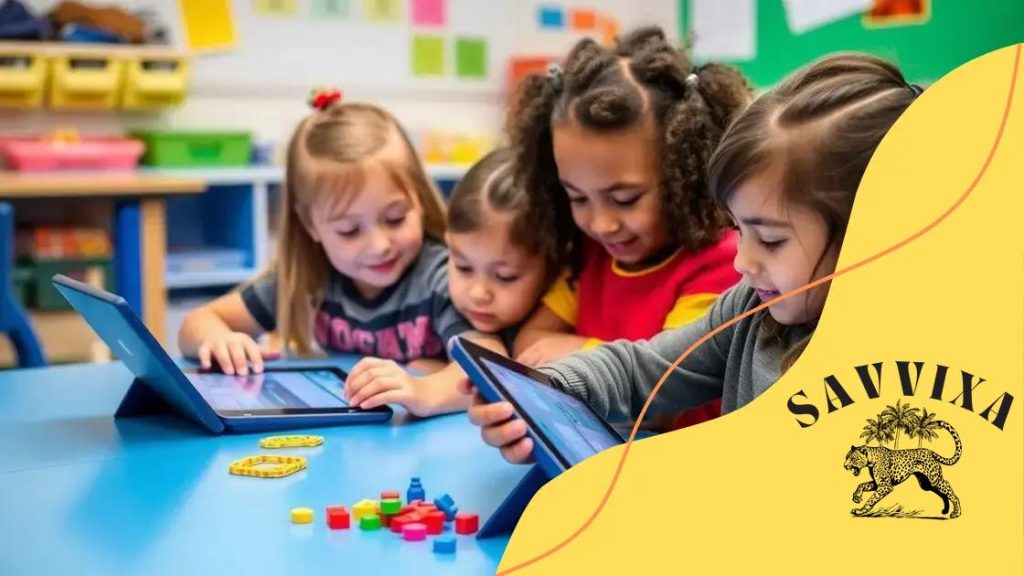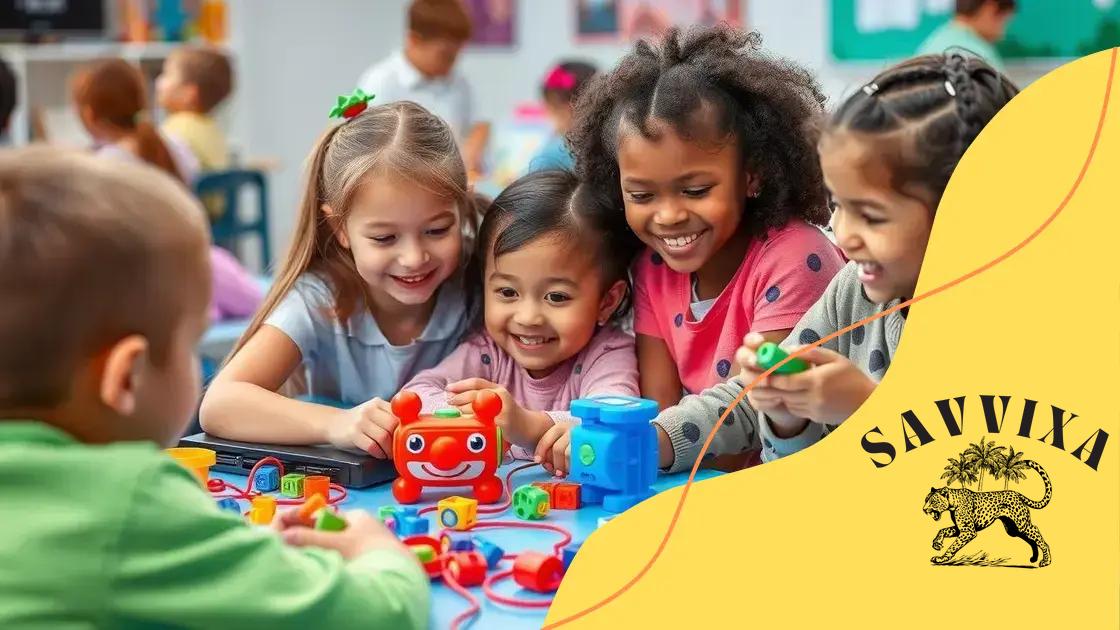Integrating coding into early education for future success

Integrating coding into early education empowers young learners by enhancing critical thinking, problem-solving skills, and creativity, equipping them for a technology-driven future.
Integrating coding into early education is becoming increasingly vital as our world becomes more technology-driven. Have you considered how learning to code can empower your child to navigate the future? This article delves into the benefits of coding for young minds and offers practical approaches to include it in their learning journey.
The importance of coding in the digital age
In today’s world, understanding how to code is more important than ever. Coding is not just for computer scientists; it’s a skill that everyone can benefit from. It equips students with the tools to think critically and solve problems effectively.
As technology continues to evolve, we must adapt education to include essential skills, like coding. This shift helps students prepare for careers that may not even exist yet.
Why Coding Matters
Coding teaches students how to approach challenges logically. By learning to code, they develop valuable skills such as:
- Critical thinking
- Creativity
- Collaboration
- Resilience
These skills are applicable in various fields, enhancing their ability to succeed in future endeavors.
Enhancing Problem-Solving Skills
Coding requires students to break down complex tasks into smaller parts, helping them learn how to tackle problems systematically. This approach is beneficial not just in coding, but in real-life situations too.
Moreover, coding promotes a growth mindset. When students encounter bugs or errors, they learn to troubleshoot and find solutions. This perseverance is essential in all aspects of life.
Incorporating coding into education is not just about teaching students to use technology. It’s about enabling them to be creators rather than just consumers of digital content. With these skills, they can innovate and make meaningful contributions to society.
How coding enhances critical thinking skills
Coding is a powerful tool that goes beyond just learning to write programs. It significantly enhances critical thinking skills in young learners. As children dive into coding, they begin to see the world through a problem-solving lens that fosters innovation.
When students learn to code, they are often faced with challenges that require them to think logically and analytically. This process of debugging teaches them to approach problems methodically, which is a key component of critical thinking.
Developing Analytical Skills
Coding allows students to break down complex problems into smaller, manageable parts. This skill is crucial in developing their ability to analyze situations and come up with effective solutions.
- Identification of problems
- Analysing various outcomes
- Evaluating different solutions
- Implementing effective strategies
By navigating through these steps, students cultivate strong analytical capabilities that can be applied not only in coding but in everyday decisions as well.
Encouraging Creativity
Alongside analytical skills, coding also unleashes creativity. When students design their own projects, they must leverage both logic and imagination. This interplay leads to innovative thinking.
Coding challenges often prompt students to brainstorm multiple solutions, encouraging them to see problems from different angles. When they realize that there can be various ways to arrive at a solution, it opens the door to creative exploration.
This combination of logic and creativity is essential for developing a well-rounded approach to problem-solving. As students engage with coding, they grow more comfortable with experimentation and risk-taking, both of which are vital traits in critical thinking.
Practical ways to introduce coding to young learners

Introducing coding to young learners can be an exciting journey! It’s essential to approach this in a way that is engaging and fun, making it enjoyable for kids to learn.
One effective way to start is by using interactive games that teach basic coding concepts. For example, there are many online platforms specifically designed to make coding fun for kids. These platforms often include colorful graphics and challenges that spark interest.
Incorporate Coding into Daily Activities
Another practical method is to weave coding into everyday activities. For example, challenges can include creating a simple recipe that has to be coded as a sequence of steps. Kids can then visually see how coding instructions translate into real-life tasks.
- Use educational apps that teach coding fundamentals.
- Introduce coding during playtime with creative projects.
- Encourage kids to build simple games or interactive stories.
- Leverage coding toys that promote hands-on learning.
These activities not only teach kids how to code but also foster critical thinking and creativity. As they engage with these fun tasks, students develop a deeper appreciation for coding.
Utilize Community Resources
Local libraries and community centers often offer coding clubs and workshops for children. These programs can help children learn fundamental concepts in a collaborative environment. Parents can encourage participation in these programs to help their children build friendships while learning.
Additionally, organizing family coding nights can make a world of difference. Each family member can take turns teaching each other what they’ve learned. This promotes teamwork and growth. Making coding a family activity can strengthen relationships while sharing valuable skills.
Finally, be sure to celebrate achievements, no matter how small. Acknowledging their success helps children build confidence and encourages them to pursue coding further. This nurturing of their skills will set them on a path to success.
Success stories from schools implementing coding
Many schools are successfully integrating coding into their curricula, creating remarkable outcomes for their students. These success stories highlight how coding education can transform learning experiences.
For instance, at a primary school in California, teachers introduced a coding program that encourages creativity and teamwork. Students work on projects that allow them to express their ideas while learning how to code. The enthusiasm in the classroom is palpable, and students often opt for coding activities during free time.
Engaging Students through Real-World Applications
Another inspiring example comes from a school district in Texas. Here, coding has become a core component of science and math classes. Students use coding to simulate scientific experiments and solve mathematical problems. This hands-on approach makes learning more relevant and engaging.
- Students learn robotics as part of their technology curriculum.
- They participate in coding competitions, fostering a spirit of friendly competition.
- Project-based learning encourages collaboration among students.
- Parents are also engaged through coding workshops.
The impact is evident; test scores have improved, and students express greater interest in STEM fields. Schools that embrace coding not only teach technical skills but also empower young learners to think critically.
Community Involvement
In another success story, a school in New York partnered with local tech companies to provide mentorship and resources. This collaboration helps students work on real-world projects, bridging the gap between education and industry. It gives students a glimpse into potential career paths in technology, inspiring them to pursue these fields further.
Feedback from students and parents alike emphasizes how coding education has changed attitudes towards learning. Students are not just consumers of technology; they become creators, and this shift in mindset is empowering. Many students report feeling more capable and confident as they tackle challenges in the classroom.
Ultimately, these stories show that coding can enrich education, providing students with skills for the future and opening doors to new opportunities. Schools that prioritize coding are preparing their students not just for their next class but for life beyond graduation.
Resources for parents to support coding education
Parents play a crucial role in supporting their children’s coding education. There are numerous resources available to help them navigate this exciting field and encourage their kids to learn more about coding.
One of the best ways for parents to begin is by exploring online platforms that offer coding courses designed specifically for kids. Websites like Code.org and Scratch provide interactive lessons that make learning to code both fun and accessible. These platforms allow children to start coding at a very young age, often without prior experience.
Books and Guides for Young Coders
In addition to online resources, there are many books that cater to young learners interested in coding. Titles such as “Hello World!” by Louise Jandl and “Coding for Kids” by Chris Roffey make complex concepts easy to understand. These books often contain fun activities and challenges that inspire creativity.
- Look for books that include projects that can be completed in an afternoon.
- Find guides that teach coding through storytelling or puzzles.
- Explore comic-style coding books that engage visual learners.
- Consider e-books that provide interactive elements.
By integrating reading with practical tasks, children can learn essential coding skills while enjoying captivating stories or activities.
Local Workshops and Classes
Many communities offer coding workshops or classes aimed at kids. Local libraries, tech centers, and community colleges often host events where students can learn coding techniques in a collaborative environment. Participating in these workshops can help students meet other kids with similar interests and develop teamwork skills.
Parents can also seek out summer camps focusing on technology and coding. These camps introduce students to new concepts while providing a fun, engaging atmosphere. Programs like Google’s Computer Science Summer Institute are excellent for students eager to dive deeper into the world of technology.
Aside from these resources, parents can encourage their children by creating a tech-friendly environment at home. Providing a computer, access to educational games, and time to explore coding can spark their interest. Engaging in conversations about what they learn fosters enthusiasm and shows that their efforts are valued.
FAQ – Frequently Asked Questions about Integrating Coding into Early Education
Why is coding important for young learners?
Coding helps develop critical thinking, problem-solving skills, and creativity, preparing children for a technology-driven world.
What resources can parents use to help their children learn coding?
Parents can explore online platforms, books, local workshops, and coding apps designed to engage children in coding concepts.
How can schools successfully implement coding programs?
Schools can incorporate coding into their curriculum through project-based learning, collaborations with local tech companies, and after-school coding clubs.
What age is best to start teaching coding to kids?
Children as young as preschool age can start learning coding through games and interactive activities designed for their developmental level.